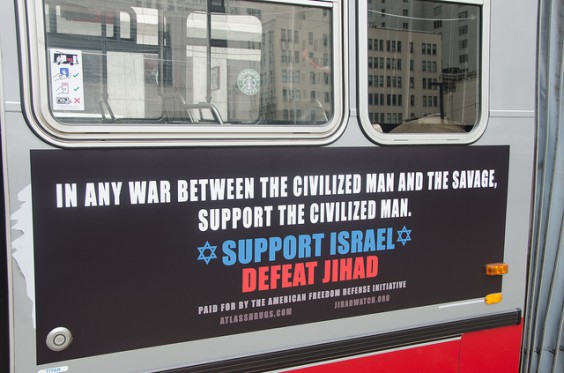Freedom of Speech, or Freedom of Hate?
Geller’s anti-Muslim ads create a culture of fear.

A Pamela Geller ad from 2012. Photo via Flickr user: Steve Rhodes
It alarmed me to read that American blogger — and certifiable lunatic — Pamela Geller is paying $100,000 to run incendiary anti-Muslim ads in New York City’s subway stations and on MTA buses. These ads, which MTA says it is legally obligated to run, were originally going to show images of journalist James Foley just before his execution. Foley’s family requested that Geller pull the ad due to its bigoted and graphic content. She replaced the image of Foley with a photograph of a masked militant holding an unidentifiable severed head. The ads imply that all Muslim moderates will become violent extremists and equate Islam with Nazism and antisemitism. It’s fear-mongering at its worst, but more people may agree with the distorted message than we’d like to believe.

- Pakistan is a country of contradictions – full of promise for growth, modernity and progress, yet shrouded by political, social and cultural issues that undermine its quest for identity and integrity. My bi-monthly column “Pakistan Unveiled” presents stories that showcase the Pakistani struggle for freedom of expression, an end to censorship, and a more open and balanced society.

- Bina Shah is a Karachi-based journalist and fiction writer and has taught writing at the university level. She is the author of four novels and two collections of short stories. She is a columnist for two major English-language newspapers in Pakistan, The Dawn and The Express Tribune, and she has contributed to international newspapers including The Independent, The Guardian, and The International Herald Tribune. She is an alumnus of the International Writers Workshop (IWP 2011).
In 2012, Geller ran similar ads stating that enemies of Israel (i.e. Palestinian Arabs) were “savages.” When the MTA tried to stop the ads and the case went to court, the judge ruled that Geller was within her First Amendment rights. Mona Eltahawy, Egyptian-American writer and activist, was arrested that September for spray-painting over the ads – she called them hate speech — in an act of civil disobedience that she claims was well within her First Amendment rights.
I’m not up to date on whose First Amendment rights take precedence, Geller’s or Eltahawy’s. However, this summer we saw similar attempts to brand Muslims as savages. During the recent war between Israel and Gaza, Elie Wiesel and Shmuley Boteach ran a full-page ad in The New York Times, The Guardian, and other publications that read: “Jews rejected child sacrifice 3,500 years ago. Now it’s Hamas’s turn.”
This was a reference, which Wiesel and Boteach further detailed, to the popular myth that Hamas uses children as human shields and suicide bombers. I call it a myth because Amnesty International’s month-long study in Gaza found no evidence that children were being used as human shields. Nevertheless, the rumor persists, peddled by Israel and its supporters in the United States.
Palestinian activists immediately protested the Wiesel and Boteach advertisements, saying their messages were tantamount to casting a blood libel on them. The phrase “blood libel” is particularly interesting: blood libel is the medieval accusation that Jews used the blood of Christian children in their religious rituals and to flavor their Passover bread. Used throughout the Middle Ages and with decreasing popularity into the early 20th century, the accusation is one of the best-known markers of antisemitism in European history. To see a similar slur used against Muslims by members of a group that endured it for centuries is a jarring reminder of how the paradigms of bigotry have shifted in the last thirteen years. The burden of proving one’s humanity is now placed on Muslim shoulders.
What effect does this continuous slander of Muslims really have on public opinion at large? Does the public dismiss them as more propaganda for a distant war, or do they have the power to actually turn people against Muslims and deny them their humanity?
One only needs a rudimentary understanding of advertising to know that advertisers and marketers use many psychological techniques to persuade their audience to “buy” the concept, object, or cause an ad is trying to sell. Association is one technique: two or more concepts become connected because they are placed in close proximity to each other. These anti-Muslim posters place images of extremist violence next to words like “Muslim” or “Quran” again and again. If people see these ads often enough, they begin to connect the concept of Muslims with the concept of violence. This kind of association will happen viscerally, even if the viewer rejects it rationally. The ads provoke the brain’s fear response, which works much faster than the brain’s ability to reason. The ads want the viewer to feel fear every time he or she comes across a Muslim, and he or she just might.
Reinforcement, when a belief or pattern of behavior is established with the promise of a reward, is another psychological technique. The anti-Muslim ads in the MTA evoke a fear response and anxiety. According to B.F. Skinner’s principle of operant conditioning, the person will change his behavior to avoid the stimulus that evoked the fear in the first place – the Muslim. First, he might avert his eyes from the subway ad to avoid negative feelings while in transit. Later, he might develop an aversion to mentions of Muslims in the media, or react with revulsion or aggression when he encounters a Muslim individual.
Although it is just a supposition, I strongly suspect these ads will affect the mental health and behavior of people who come across them, especially if they see them at random intervals throughout their day. That is the evil genius of placing the ads in the subway or on the bus, where they can pop up at any time and play on the fears of New Yorkers who may already feel vulnerable to terrorist attacks. Ads like Elie Wiesel’s in The New York Times may not work on such a primeval level, but through their use of specious argument they work to reinforce – in the strengthening sense of the word – stereotypes that Muslims are inhuman and violent. In that case, the ads should be banned, if not on the grounds of hate speech, then on the grounds that they may damage an unsuspecting public’s mental health.





One Comment on "Freedom of Speech, or Freedom of Hate?"
Trackbacks for this post